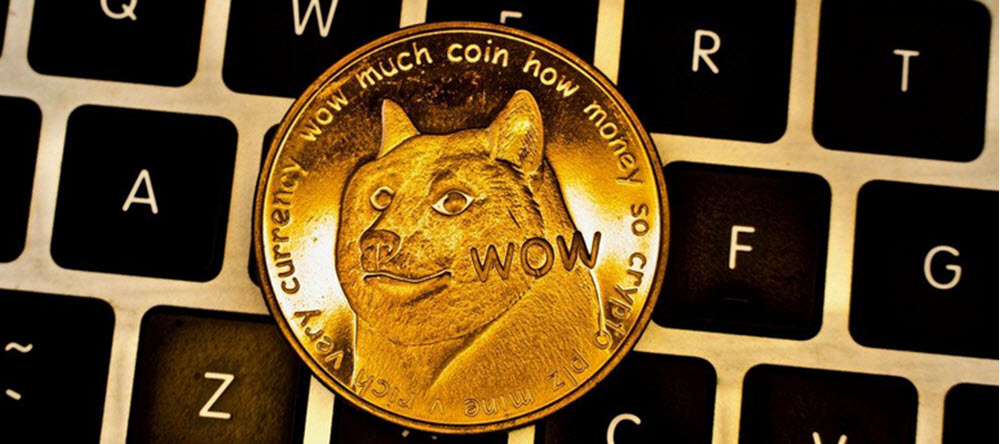Dogecoin is a cryptocurrency launched in December 2013. It was initially marketed as a “joke currency” but quickly gained a dedicated online community of users. By January 2014, the Dogecoin had a capitalization of 60 million USD.
The Dogecoin derives its name from the Doge meme (the one with he Shiba Inu dog).
Few mainstream vendors accept payment in Dogecoin, but the currency has become a well-established currency for donating online, including tipping the producers of appriciated content. Some trading of Dogecoin for tangible items is taking place within online communities, such as Reddit.
In February 2014, a Dogecoin ATM was showcased at Coinfest in Vancouver, Canada. The following month, two ATMs supporting various cryptocurrencies, including Dogecoin, were inaugurated in Tijuana, Mexico.

Short facts about Dogecoin



- Launch: December 6, 2013
- Abbreviation: DOGE
- Symbol: Ð
- Source model: Open source
- Hash function: Scrypt-based
- Block time: 1 minute
Dogecoin mining
When Dogecoin was launched in December 2013, the intention was to produce no more than 100 billion dogecoins. Later, it was announced that the Dogecoin network would impose no limit on the number of dogecoins produced.
Compared to most other cryptocurrencies, Dogecoin was launched with a rapid coin production schedule, and by mid-2015, the original target of 100 billion coins had been reached. The 100 billionth dogecoin was mined in June that year.
Just like Luckycoin (upon which it is based), Dogecoin uses scrypt technology in its proof-of-work algorith. Because of the scrypt, Dogecoin miners cannot utilize SHA-256 mining equipment (a type of equiment commonly used by Bitcoin miners). The scrypt also makes it difficult (albeit not impossible) to create dedicated FPGA and ASIC devices for Dogecoin mining.
Luckycoin is based on a system where a randomized reward is given out for each mined block, instead of a static reward, and Dogecoin relied on this reward system until March 2014 when it switched to static rewards.
Compared to Litecoin (the cryptocurrency upon which Luckycoin is based), Dogecoin has a noticably faster blocktime: 1 minute instead of 2.5 minutes.
Exchange trading
There are quite a few platforms available online where you can trade in Dogecoin against other cryptocurrencies, especially Bitcoin and Litecoin.
One of the first exchanges to allow trading in DOGE/USD was AltQuick.co, who was soon followed by Vault of Satoshi – who also added DOGE/CAD trading to the plate.
If you want to trade DOGE/EUR or DOGE/GBP, you can for instance do it at the UK-based exchange Yacuna.
Examples of exchanges where Dogecoin can be traded against CNY (Renminbi, the currency of China) are Bter, BTC38 and Mengmengbi.
The Hong Kong-based exchange Asia Nexgen have supported the trading of Dogecoins against a wide range of currencies since February 2014.
Background
Creation
The Dogecoin saga starts with Billy Markus, a programmer based in Portland, Oregon, USA, who wanted to make a not-so-serious cryptocurrency that could reach a broader demographic than Bitcoin. Around the same time, Jackson Palmer – a member of Adobe Systems’ marketing department in Sydney, Australia – was encouraged to help turn this idea into reality and eventually bought the domain dogecoin.com and put up a splash screen feating the coin’s logo. After the site was linked to in an IRC chat room, it caught the attention of Markus, who reached out to Palmer and started working on making Dogecoin a reality.
Billy Markus used the cryptocurreny Luckycoin as a base for his work with Dogecoin. Luckycoin, in turn, is based on Litecoin, which is one of the early Bitcoin spinoffs.
Launch
Dogecoin was launched on December 6, 2013 and rapidly gained a lot of fans.
On December 19, the price of Dogecoin rose rapidly. In 72 hours, it increased nearly 300% in value against the USD, going from 0.00026 USD to 0.00095 USD per 1 dogecoin. Just a few days later, the price dropped by 80% – partly because big mining pools had formed that mined large amounts of dogecoins. (At the time, very little computing power was required to mine dogecoins.)
First large-scale theft
The first known large-scale theft of dogecoins occured on Christmas Day 2013, when someone hacked the online cryptocurrency wallet platform Dogewallet and stole millions of dogecoins.
Even though this was a negative event, it helped promote the Dogecoin since the theft caused a lot of buzz online and made more people aware of Dogecoin’s existence.
The Dogecoin community launched the campaign SaveDogemas to help the victims of the theft. After roughly a month, enough money had been donated to cover all of the stolen dogecoins.
Trading volume
In January 2014, the trading volume of Dogecoin briefly surpassed that of Bitcoin and all the other cryptocurrencies combined. Notably, the market capitalization of Dogecoin was still much smaller than that of Bitcoin.
Data from January 31, 2014, show that the trading volume for Dogecoin across the major exchanges where it was traded amounted to 1.05 million USD, and the market capitalization was approximately 60 million USD. The most traded currency pairs at the three exchanges that accounted for the majority of volume (Bter, Cryptsy and Vircurex) was DOGE/BTC, DOGE/CNY and DOGE/LTC.
Fundraising
The Dogecoin community has a history of launching fundraising events. As mentioned above, Dogecoin enthusiats did for instance band together to help those who had their dogecoins stolen by a hacker on Christmas Day 2013.
Other examples of Dogecoin campaigns:
- Fundraising to raise money for the Jamaican Bobsled Team, which had qualified for the 2014 Sochi Winter Olympics but lacked the money to go. Roughly $40,000 was needed but $129,687 was raised between January 19 and January 22, 2014, far surpasing the initial target.
- Fundraising for Shiva Keshavan, the first Indian representative to compete in luge at the Winter Olympic Games.
- Fundraising to build a well in the Tana River basin in Kenya in cooperation with Charity: Water.
- Fundraising to sponsor NASCAR driver Josh Wise.
This article was last updated on: May 29, 2019
